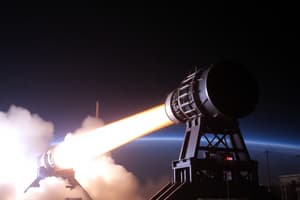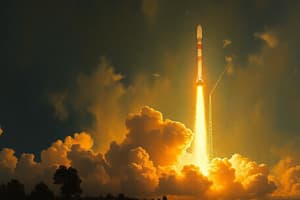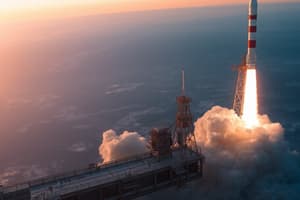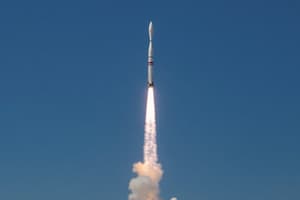Podcast
Questions and Answers
What is the primary difference between the RPL's previous focus on high-altitude rockets and their current focus on sounding rockets?
What is the primary difference between the RPL's previous focus on high-altitude rockets and their current focus on sounding rockets?
- The RPL now seeks to design rockets capable of achieving greater heights than before.
- High-altitude rockets are primarily for research purposes, while sounding rockets are for entertainment.
- High-altitude rockets are subject to stricter regulations, while sounding rockets are not.
- High-altitude rockets carry heavier payloads, while sounding rockets carry scientific instruments. (correct)
What is the main reason behind the RPL's shift to developing sounding rockets?
What is the main reason behind the RPL's shift to developing sounding rockets?
- The team wants to develop a new technology for sounding rockets that will be more accurate.
- Sounding rockets are more cost-effective to build and launch compared to high-altitude rockets.
- The team believes that sounding rockets can reach greater altitudes than high-altitude rockets.
- The team wants to avoid the hassle of obtaining special clearances for higher altitude flights. (correct)
What is the approximate maximum altitude allowed for amateur rocketry?
What is the approximate maximum altitude allowed for amateur rocketry?
- 530,000 feet
- 490,000 feet (correct)
- 470,000 feet
- 510,000 feet
The RPL's decision to shift to sounding rockets suggests a change in their primary objective. What is this change?
The RPL's decision to shift to sounding rockets suggests a change in their primary objective. What is this change?
Based on the content, what is the likely future use of the RPL's sounding rockets?
Based on the content, what is the likely future use of the RPL's sounding rockets?
Which of the following technological advancements contributed to the success of the Aftershock II rocket? (Select all that apply)
Which of the following technological advancements contributed to the success of the Aftershock II rocket? (Select all that apply)
What is the significance of the Kármán line in the context of the Aftershock II rocket launch?
What is the significance of the Kármán line in the context of the Aftershock II rocket launch?
Based on the information provided, what is the primary purpose of RPL?
Based on the information provided, what is the primary purpose of RPL?
What specific challenge did the titanium-coated fins and heat-resistant paint address for the Aftershock II rocket?
What specific challenge did the titanium-coated fins and heat-resistant paint address for the Aftershock II rocket?
What does Jayna Rybner's statement suggest about the significance of the Aftershock II rocket launch?
What does Jayna Rybner's statement suggest about the significance of the Aftershock II rocket launch?
What can be inferred about the relationship between RPL and the students involved in the Aftershock II project?
What can be inferred about the relationship between RPL and the students involved in the Aftershock II project?
What was the approximate altitude difference between the Aftershock II's altitude record and the previous amateur record?
What was the approximate altitude difference between the Aftershock II's altitude record and the previous amateur record?
Based on the information provided, how long did it take for Aftershock II to reach its peak speed?
Based on the information provided, how long did it take for Aftershock II to reach its peak speed?
At what approximate time during its flight did Aftershock II leave Earth's atmosphere?
At what approximate time during its flight did Aftershock II leave Earth's atmosphere?
What was the main purpose of the nose cone detaching and deploying its parachute?
What was the main purpose of the nose cone detaching and deploying its parachute?
According to the content, how many times the speed of sound did Aftershock II reach at its peak velocity?
According to the content, how many times the speed of sound did Aftershock II reach at its peak velocity?
What is the equivalent speed of Aftershock II's peak velocity in kilometers per hour?
What is the equivalent speed of Aftershock II's peak velocity in kilometers per hour?
Which of the following comparisons between Aftershock II and GoFast is CORRECT according to the content?
Which of the following comparisons between Aftershock II and GoFast is CORRECT according to the content?
What is the approximate height of Aftershock II in meters?
What is the approximate height of Aftershock II in meters?
Based on the information provided, which of the following statements about Aftershock II is TRUE?
Based on the information provided, which of the following statements about Aftershock II is TRUE?
What was the primary purpose of Aftershock II's mission?
What was the primary purpose of Aftershock II's mission?
Flashcards
Sounding Rockets
Sounding Rockets
Rockets designed to carry scientific instruments for research flight.
Rocket Propulsion Lab (RPL)
Rocket Propulsion Lab (RPL)
A student group at USC focused on rocketry and propulsion projects.
High-altitude Rockets Limit
High-altitude Rockets Limit
The maximum altitude for amateur rocketry, which is 490,000 feet.
Research Flight Payloads
Research Flight Payloads
Signup and view all the flashcards
Cleared Regulations in Rocketry
Cleared Regulations in Rocketry
Signup and view all the flashcards
Aftershock II
Aftershock II
Signup and view all the flashcards
Altitude Record
Altitude Record
Signup and view all the flashcards
Launch Date
Launch Date
Signup and view all the flashcards
Black Rock Desert
Black Rock Desert
Signup and view all the flashcards
Speed of Sound
Speed of Sound
Signup and view all the flashcards
Maximum Speed
Maximum Speed
Signup and view all the flashcards
Ascent Duration
Ascent Duration
Signup and view all the flashcards
Nose Cone Detachment
Nose Cone Detachment
Signup and view all the flashcards
Rocket Recovery
Rocket Recovery
Signup and view all the flashcards
Previous Record Holder
Previous Record Holder
Signup and view all the flashcards
RPL
RPL
Signup and view all the flashcards
Kármán line
Kármán line
Signup and view all the flashcards
Technological innovations
Technological innovations
Signup and view all the flashcards
Titanium-coated fins
Titanium-coated fins
Signup and view all the flashcards
Real-time tracking
Real-time tracking
Signup and view all the flashcards
Study Notes
Rocket Success
- A rocket built by students at the University of Southern California (USC) Rocket Propulsion Lab (RPL) shattered a 20-year record.
- Aftershock II, launched from Nevada's Black Rock Desert on October 20, 2024, reached an altitude of 470,000 feet (143.3 km).
- This was 90,000 feet (27.4 km) higher than the previous amateur rocket altitude record of 380,000 feet (115.8 km), set by the Civilian Space Exploration Team's GoFast rocket in 2004.
Innovative Design
- The rocket's success was due to technological innovations.
- A 100-person team developed titanium-coated fins and a new heat-resistant paint enabling the rocket to withstand extreme temperatures generated at high speeds.
- Student-designed computer systems tracked the rocket's position and sent live data throughout the flight.
Reaching New Heights
- The 14-foot (4 m) tall Aftershock II broke the sound barrier within two seconds of launch, reaching a maximum speed of 3,600 mph (5,800 km/h).
- This speed is 5.5 times the speed of sound, and slightly exceeded the speed record set by GoFast in 2004.
- Aftershock II continued its ascent after its engine burnt out shortly after launch, leaving Earth's atmosphere in about 85 seconds.
- The rocket reached its peak altitude in 92 seconds.
- At this point, the rocket's nose cone detached and deployed its parachute for a safe landing.
Student-Led Initiative
- RPL, founded in 2005, is focused on launching student-designed and built rockets into space.
- The student-led group made history in 2019 when their Traveler IV rocket became the first student-built rocket to cross the Kármán line (100 km) above Earth's surface.
- This imaginary line, 328,083 feet (100 km), marks the internationally recognized edge of space.
Studying That Suits You
Use AI to generate personalized quizzes and flashcards to suit your learning preferences.





